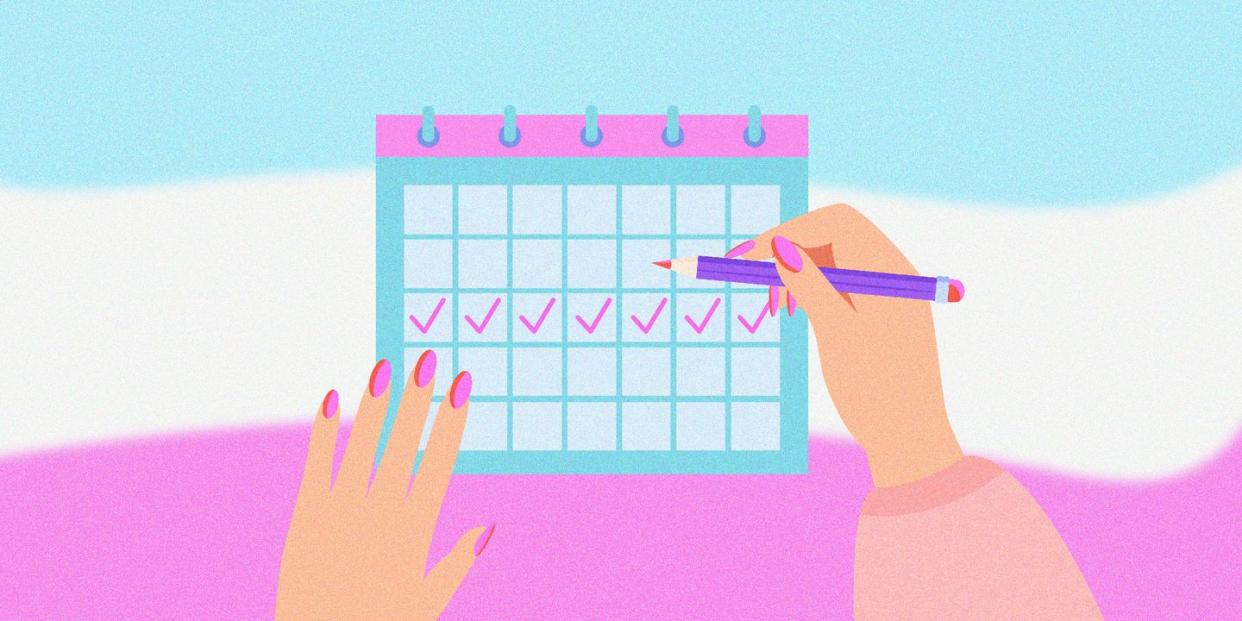What Celebrating Transgender Awareness Week Means for the LGBTQ+ Community

Every year, the LGBTQ+ community celebrates Transgender Awareness Week from November 13 to November 19 to acknowledge its trans members and celebrate their experiences. While living their truth should be celebrated year-round, trans people continue to face discrimination in their daily lives — notably, from their governments through harmful laws targeting transgender youth. According to The Trevor Project's 2022 National Survey on LGBTQ Youth Mental Health, 71% of transgender and non-binary youth reported that they have experienced discrimination based on their gender identity, and 37% reported that they have been physically threatened or harmed due to their gender identity. A 2022 report from the University of California Los Angeles' Williams Institute also found that 1.6 million people over the age of 13 identify as trans in the United States, with 300,000 of those people being transgender youth.
Transgender Awareness Week leads up to Transgender Day of Remembrance, which takes place on November 20 each year. "Transgender Awareness Week and Transgender Day of Remembrance allow us to recognize the experiences and struggles that trans people have been subjected to, highlight the strength and resilience of the trans community, and give us the opportunity to encourage our community to continue being a better ally every day of the year," Keygan Miller (They/Them), Public Training Manager at The Trevor Project, tells Seventeen.
We spoke with Miller about the importance of Transgender Awareness Week, what its celebration means to the queer community, and how non-queer folks can show up and become better allies.
What is Transgender Awareness Week and why is it celebrated?

To put it simply, Transgender Awareness Week celebrates transgender people, their stories, and their experiences through education and advocacy. Miller also describes it as an opportunity to rally around the trans community before honoring victims of transphobia on Transgender Day of Remembrance. "Transgender Awareness Week encourages individuals, organizations, and communities to organize events and create educational opportunities to share information about the trans experience, promote LGBTQ visibility and acceptance, and address issues that members of the transgender community face," Miller says.
"In the past year, the LGBTQ community has experienced a record-breaking wave of anti-trans bills and rhetoric, while the pandemic only exacerbated feelings of isolation and nonacceptance," they continue before explaining that LGBTQ youth generally experience higher rates of depression, anxiety, and suicide attempts due to increased instances of discrimination and rejection. "It is important that we recognize the resilience of the transgender community, uplift their voices, and celebrate their impact. Being out as trans and living as one’s true, authentic self can be a very liberating as well as challenging experience, so it is critical we take a moment to foster acceptance and allyship [during Transgender Awareness Week]."
When was the first Transgender Awareness Week celebrated and what is the history behind it?
Transgender Awareness Week is a week-long celebration prior to Transgender Day of Remembrance, which honors lives lost from anti-trans violence. "Started by trans activist Gwendolyn Ann Smith in 1999, Transgender Day of Remembrance takes place each year on November 20 and was initially created to memorialize Rita Hester, a transgender woman who was murdered in 1998," Miller says.
As for the origin of Transgender Awareness Week, Miller explains there have been multiple week-long celebrations that seem to come from trans and non-binary community activists who "sought out a way to recognize that the community is greater than the negativity and loss that is so often highlighted."
How are Transgender Awareness Week and International Transgender Day of Visibility related?
International Transgender Day of Visibility is celebrated each year on March 31 and was founded by transgender activist Rachel Crandall in 2009 to bring awareness to the complexities of trans visibility, representation, and joy. When International Transgender Day of Visibility was created, Transgender Day for Remembrance was the only day that acknowledged and celebrated transgender people up until that point.
"While it was important to honor those in our community who had died, it was noted that we really needed a way to honor those currently living and to celebrate our existence," Miller explains. "Placed several months apart, this allowed for us to give appropriate time and place for both grief and joy. Both Transgender Awareness Week and International Transgender Day of Visibility stand as important commemorations of the transgender community and reminders to advocate for their rights – not just in these moments, but year-round."
What are some activities people can participate in to celebrate Transgender Awareness Week? How can young people stay involved and show up for their trans friends and community?
There are plenty of ways to actively celebrate trans folks, even if you don't identify as trans yourself. Attending protests, lobbying for legislation that protects the rights of LGTBQ+ people, donating to organizations and causes impacting the community, honoring lives lost through memorials and vigils, and educating yourself on trans experiences through books, movies, and TV shows are a few ways you can show up for the community.
"It can be tough for transgender and non-binary people to constantly educate or be subjected to others' curiosity," Miller explains. "One of the best ways to be an ally is to educate yourself on the basics of gender identity and expression so you can better support others. Learning is an ongoing process, so it’s okay to acknowledge that you may not know everything."
For more resources surrounding the LGBTQ+ community and how to show support, visit Seventeen and The Trevor Project.
You Might Also Like

